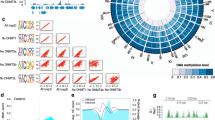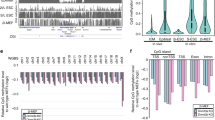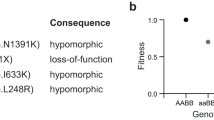Abstract
CpG methylation is essential for mouse development1 as well as gene regulation and genome stability2,3,4,5. Many features of mammalian DNA methylation are consistent with the action of a de novo methyltransferase that establishes methylation patterns during early development and the post-replicative maintenance of these patterns by a maintenance methyltransferase6. The mouse methyltransferase Dnmt1 (encoded by Dnmt) shows a preference for hemimethylated substrates in vitro , making the enzyme a candidate for a maintenance methyltransferase7,8. Dnmt1 also has de novo methylation activity in vitro 9, but the significance of this finding is unclear, because mouse embryonic stem (ES) cells contain a de novo methylating activity unrelated to Dnmt1 (ref. 10). Recently, the Dnmt3 family of methyltransferases has been identified and shown in vitro to catalyse de novo methylation11. To analyse the function of these enzymes, we expressed Dnmt and Dnmt3a in transgenic Drosophila melanogaster. The absence of endogenous methylation in Drosophila12,13 facilitates detection of experimentally induced methylation changes. In this system, Dnmt3a functioned as a de novo methyltransferase, whereas Dnmt1 had no detectable de novo methylation activity. When co-expressed, Dnmt1 and Dnmt3a cooperated to establish and maintain methylation patterns. Genomic DNA methylation impaired the viability of transgenic flies, suggesting that cytosine methylation has functional consequences for Drosophila development.
This is a preview of subscription content, access via your institution
Access options
Subscribe to this journal
Receive 12 print issues and online access
$209.00 per year
only $17.42 per issue
Buy this article
- Purchase on Springer Link
- Instant access to full article PDF
Prices may be subject to local taxes which are calculated during checkout




Similar content being viewed by others
References
Li, E., Bestor, T.H. & Jaenisch, R. Targeted mutation of the DNA methyltransferase gene results in embryonic lethality. Cell 69, 915–926 (1992).
Li, E., Beard, C. & Jaenisch, R. Role for DNA methylation in genomic imprinting. Nature 366, 362–365 ( 1993).
Panning, B. & Jaenisch, R. DNA hypomethylation can activate Xist expression and silence X-linked genes. Genes Dev. 10, 1991–2002 (1996).
Chen, R.Z., Pettersson, U., Beard, C., Jackson-Grusby, L. & Jaenisch, R. DNA hypomethylation leads to elevated mutation rates. Nature 395, 89– 93 (1998).
Walsh, C.P., Chaillet, J.R. & Bestor, T.H. Transcription of IAP endogenous retroviruses is constrained by cytosine methylation. Nature Genet. 20, 116–117 (1998).
Jaenisch, R. DNA methylation and imprinting: why bother? Trends Genet. 13, 323–329 (1997).
Gruenbaum, Y., Cedar, H. & Razin, A. Substrate and sequence specificity of a eukaryotic DNA methylase. Nature 295, 620– 622 (1982).
Bestor, T.H. & Ingram, V.M. Two DNA methyltransferases from murine erythroleukemia cells: purification, sequence specificity, and mode of interaction with DNA. Proc. Natl Acad. Sci. USA 80, 5559–5563 (1983).
Yoder, J.A., Soman, N.S., Verdine, G.L. & Bestor, T.H. DNA (cytosine-5)-methyltransferases in mouse cells and tissues. Studies with a mechanism-based probe. J. Mol. Biol. 270, 385–395 (1997).
Lei, H. et al. DNA cytosine methyltransferase activities in mouse embryonic stem cells. Development 122, 3195– 3205 (1996).
Okano, M., Xie, S. & Li, E. Cloning and characterization of a family of novel mammalian DNA (cytosine-5) methyltransferases. Nature Genet. 19, 219 –220 (1998).
Urieli-Shoval, S., Gruenbaum, Y., Sedat, J. & Razin, A. The absence of detectable methylated bases in Drosophila melanogaster DNA. FEBS Lett. 146, 148–152 ( 1982).
Patel, C.V. & Gopinathan, K.P. Determination of trace amounts of 5-methylcytosine in DNA by reverse-phase high-performance liquid chromatography. Anal. Biochem. 164, 164– 169 (1987).
Brand, A.H., Manoukian, A.S. & Perrimon, N. Ectopic expression in Drosophila. Methods Cell Biol. 44, 635–654 (1994).
Sutherland, E., Coe, L. & Raleigh, E.A. McrBC: a multisubunit GTP-dependent restriction endonuclease. J. Mol. Biol. 225, 327– 348 (1992).
Danilevskaya, O., Slot, F., Pavlova, M. & Pardue, M.L. Structure of the Drosophila HeT-A transposon: a retrotransposon-like element forming telomeres. Chromosoma 103, 215– 224 (1994).
Bestor, T.H. Activation of mammalian DNA methyltransferase by cleavage of a Zn binding regulatory domain. EMBO J. 11, 2611– 2617 (1992).
Holliday, R. & Pugh, J.E. DNA modification mechanisms and gene activity during development. Science 187, 226–232 (1975).
Riggs, A.D. X inactivation, differentiation, and DNA methylation. Cytogenet. Cell Genet. 14, 9–25 ( 1975).
Tucker, K.L. et al. Germ-line passage is required for establishment of methylation and expression patterns of imprinted but not of nonimprinted genes. Genes Dev. 10, 1008–1020 (1996).
Wines, D.R., Talbert, P.B., Clark, D.V. & Henikoff, S. Introduction of a DNA methyltransferase into Drosophila to probe chromatin structure in vivo. Chromosoma 104, 332–340 (1996).
Becker, P.B., Ruppert, S. & Schütz, G. Genomic footprinting reveals cell type-specific DNA binding of ubiquitous factors. Cell 51, 435–443 (1987).
Iguchi-Ariga, S.M. & Schaffner, W. CpG methylation of the cAMP-responsive enhancer/promoter sequence TGACGTCA abolishes specific factor binding as well as transcriptional activation. Genes Dev. 3, 612–619 ( 1989).
Ng, H.H. & Bird, A. DNA methylation and chromatin modification. Curr. Opin. Genet. Dev. 9, 158– 163 (1999).
Kudo, S. Methyl-CpG-binding protein MeCP2 represses Sp-1 activated transcription of the human leukosialin gene when the promoter is methylated. Mol. Cell. Biol. 18, 5492–5499 (1998).
Wade, P.A. et al. Mi-2 complex couples DNA methylation to chromatin remodelling and histone deacetylation. Nature Genet. 23, 62–66 (1999).
Spradling, A.L. & Rubin, G.M. Transformation of cloned P elements into Drosophila germ line chromosomes. Science 218, 341–347 ( 1982).
Zink, D. & Paro, R. Drosophila Polycomb-group regulated chromatin inhibits the accessibility of a trans-activator to its target DNA. EMBO J. 14, 5660–5671 (1995).
Ashburner, M. Drosophila: A Laboratory Manual (Cold Spring Harbor Laboratory Press, Cold Spring Harbor, 1989).
Kumar, S., Cheng, X., Pflugrath, J.W. & Roberts, R.J. Purification, crystallization, and preliminary X-ray diffraction analysis of an M.HhaI-AdoMet complex. Biochemistry 31, 8648–8653 (1992).
Gruenbaum, Y., Stein, R., Cedar, H. & Razin, A. Methylation of CpG sequences in eukaryotic DNA. FEBS Lett. 124, 67–71 (1981).
Acknowledgements
We thank D. Biniszkiewicz for Dnmt cDNA; D. Schneider and M. Voas for help with pictures; I. Rebay for fly strains; and H. LeBlanc for helpful discussions. This work was supported by NIH grants GM39341 (to T.O.-W.) and 5-R35-CA44339 (to R.J). F.L. received a research fellowship from the Deutsche Forschungsgemeinschaft.
Author information
Authors and Affiliations
Corresponding author
Rights and permissions
About this article
Cite this article
Lyko, F., Ramsahoye, B., Kashevsky, H. et al. Mammalian (cytosine-5) methyltransferases cause genomic DNA methylation and lethality in Drosophila. Nat Genet 23, 363–366 (1999). https://doi.org/10.1038/15551
Received:
Accepted:
Issue Date:
DOI: https://doi.org/10.1038/15551
This article is cited by
-
Universality of the DNA methylation codes in Eucaryotes
Scientific Reports (2019)
-
Methyl-CpG binding domain proteins inhibit interspecies courtship and promote aggression in Drosophila
Scientific Reports (2017)
-
Two domain-disrupted hda6 alleles have opposite epigenetic effects on transgenes and some endogenous targets
Scientific Reports (2015)
-
Association between hMLH1 hypermethylation and JC virus (JCV) infection in human colorectal cancer (CRC)
Clinical Epigenetics (2011)
-
Accessibility of the Drosophila genome discriminates PcG repression, H4K16 acetylation and replication timing
Nature Structural & Molecular Biology (2010)



